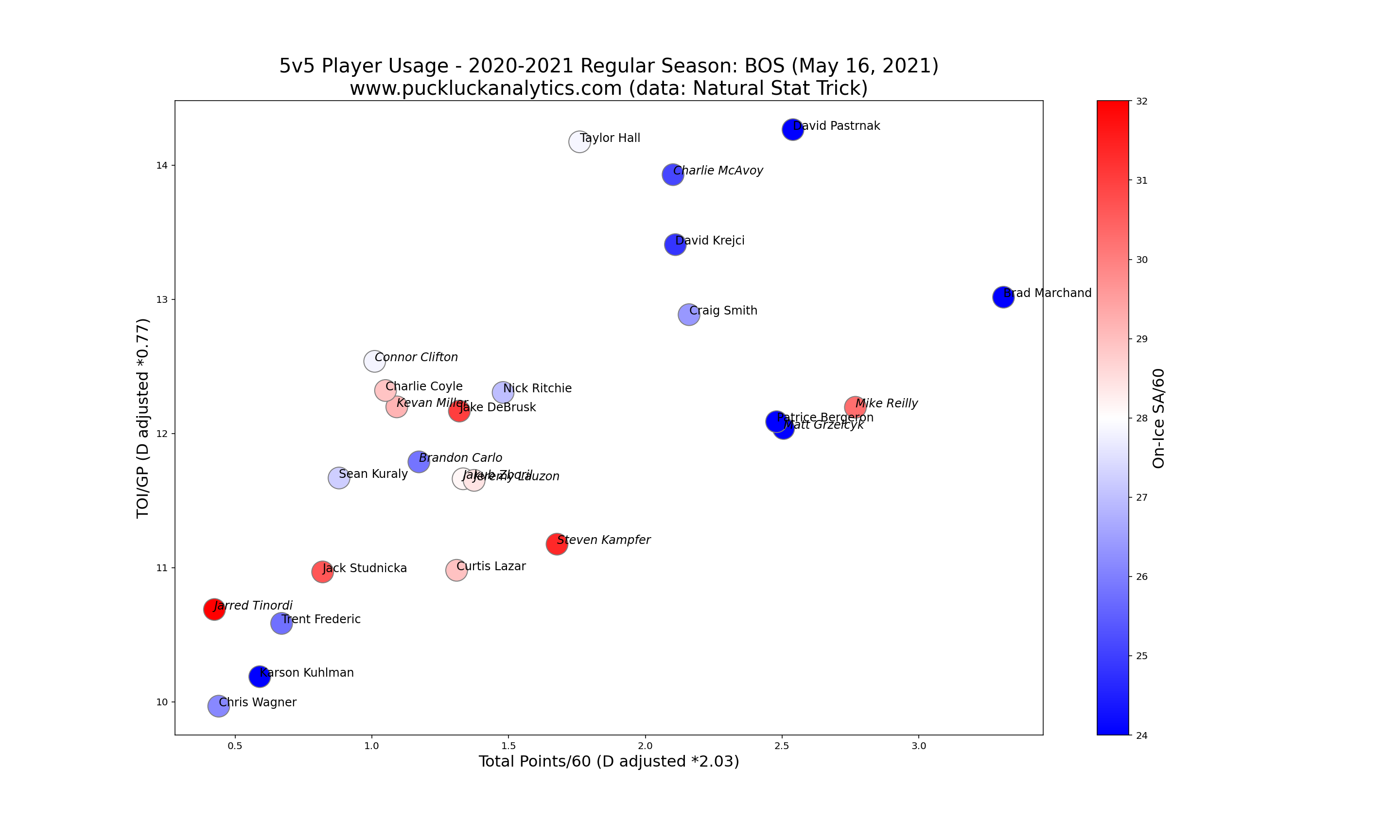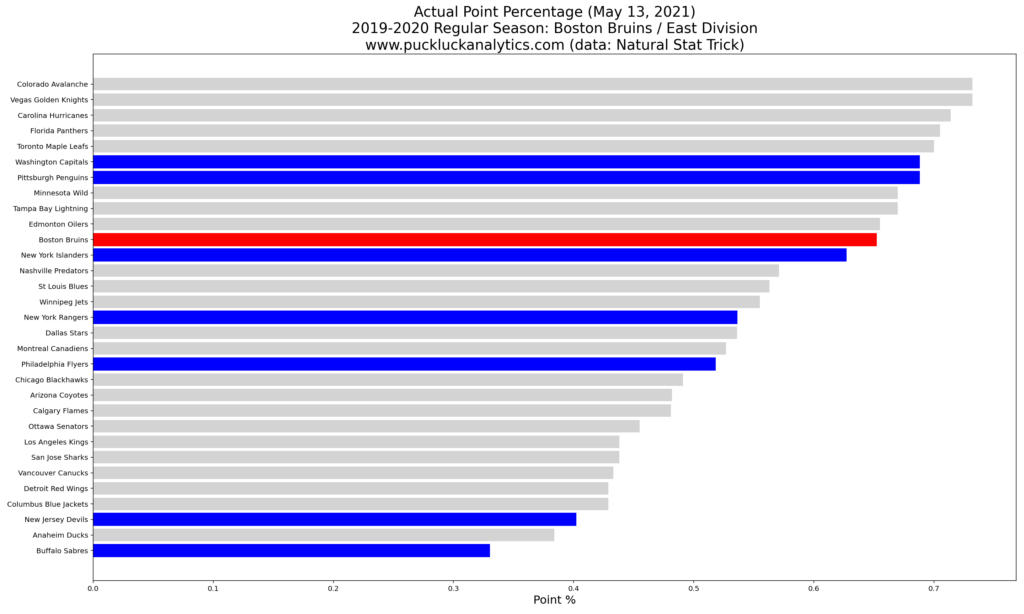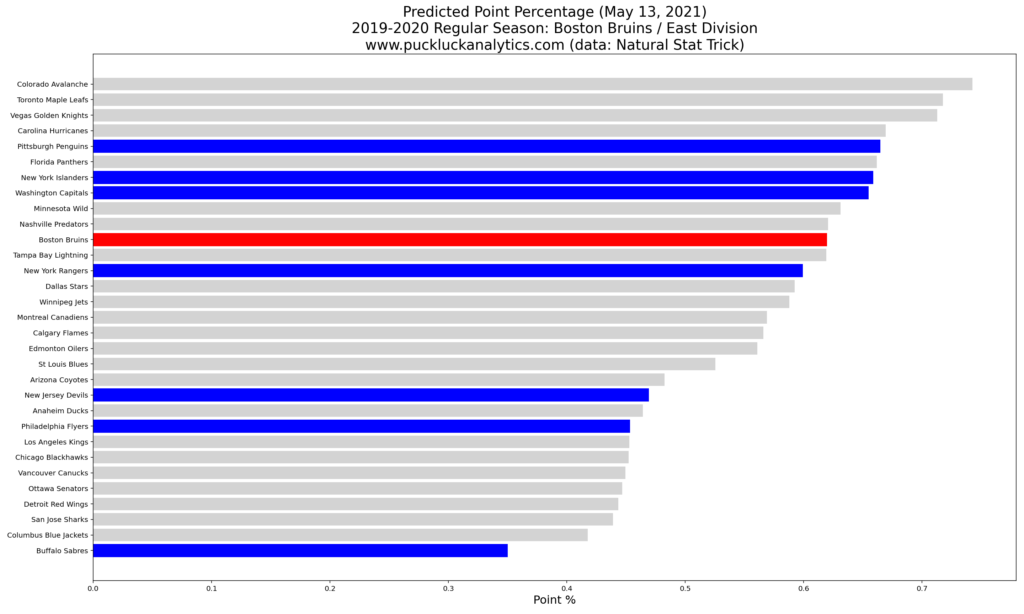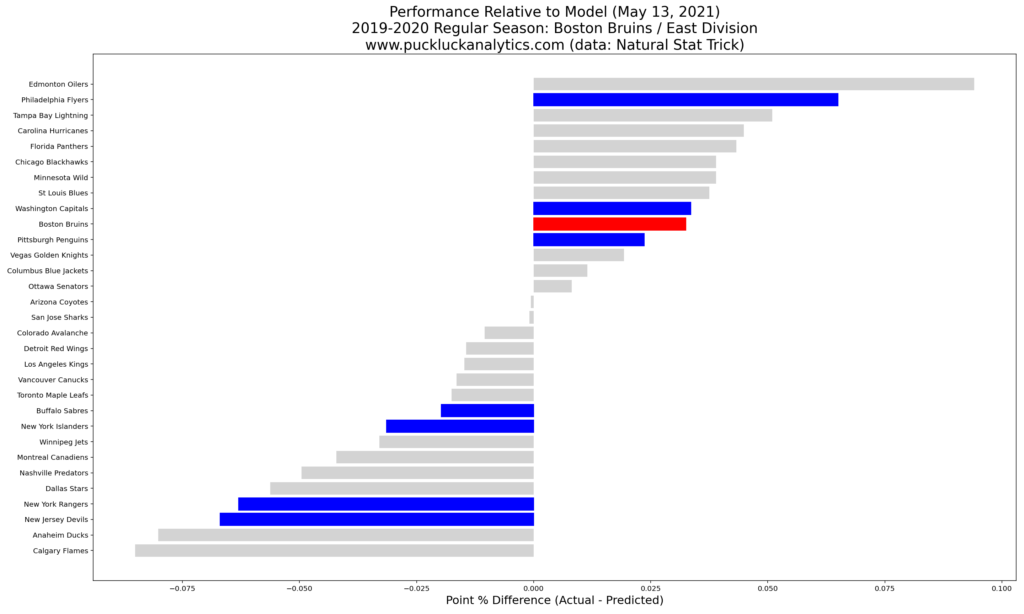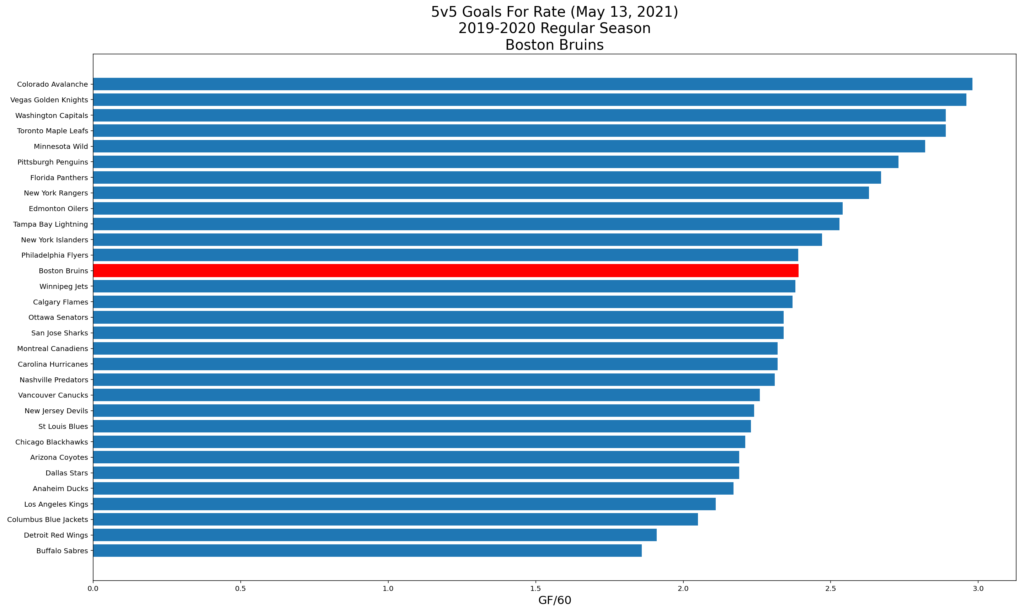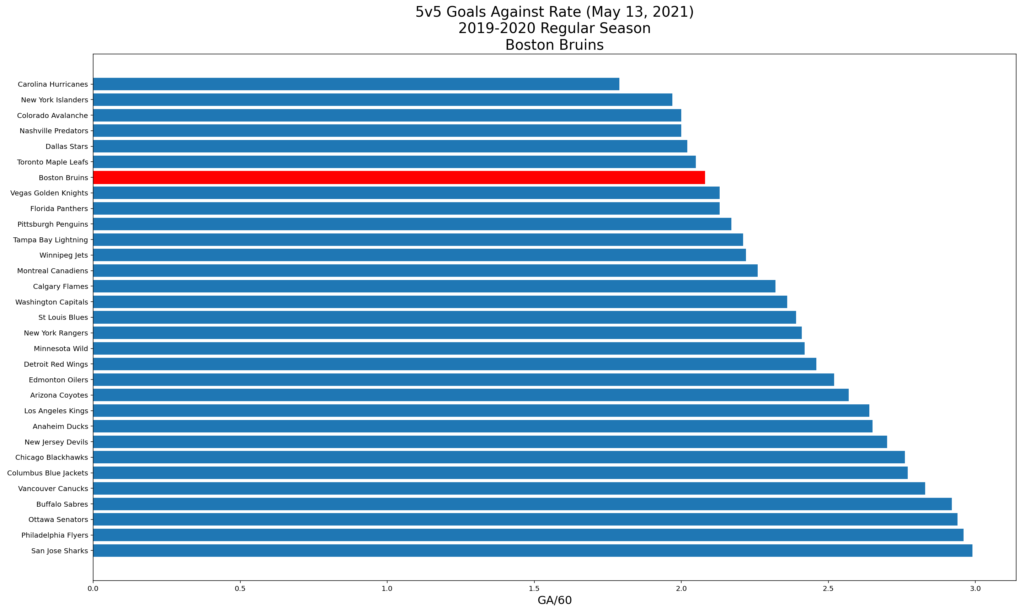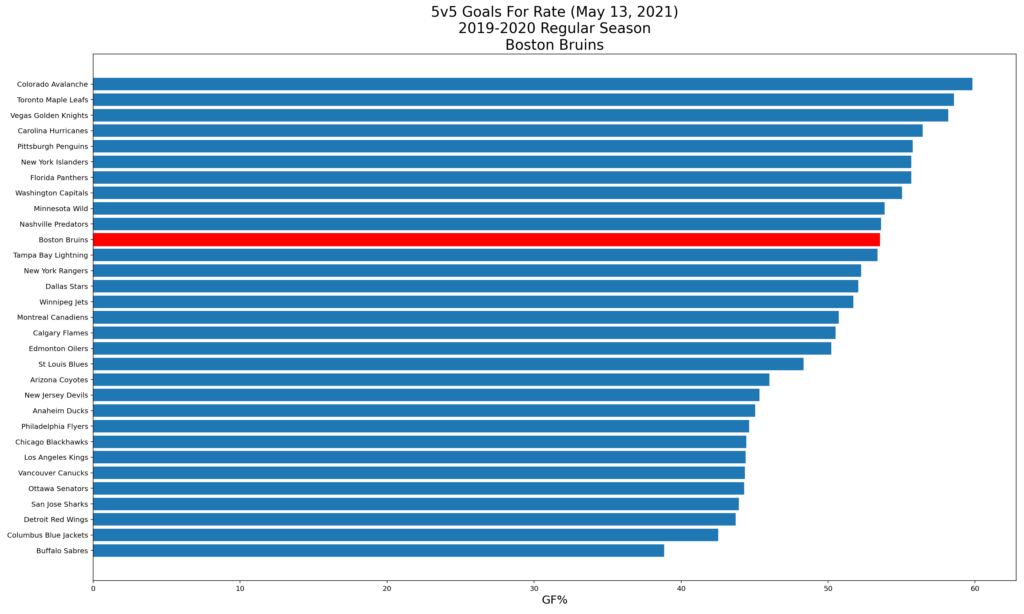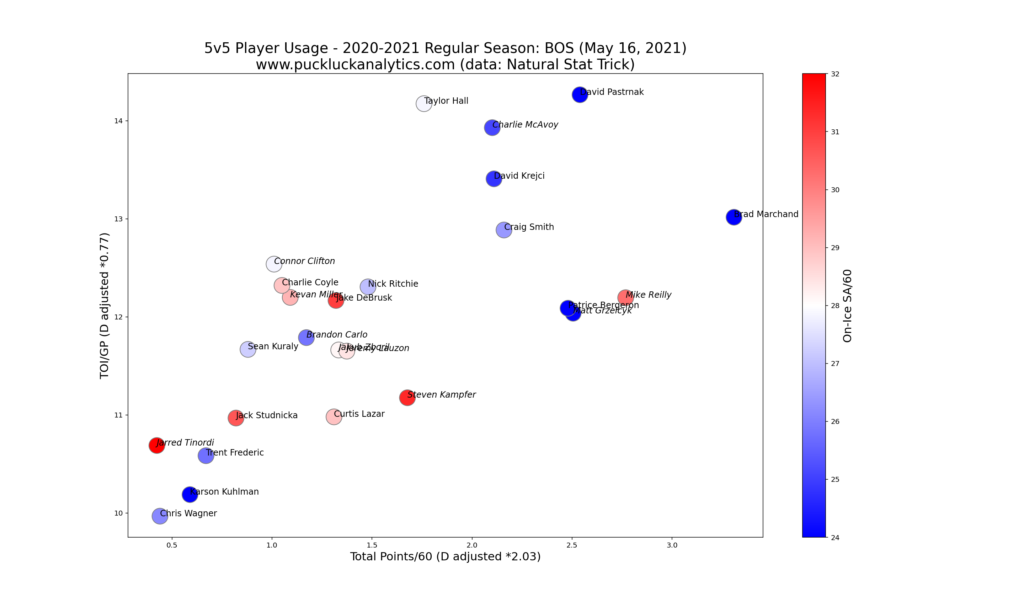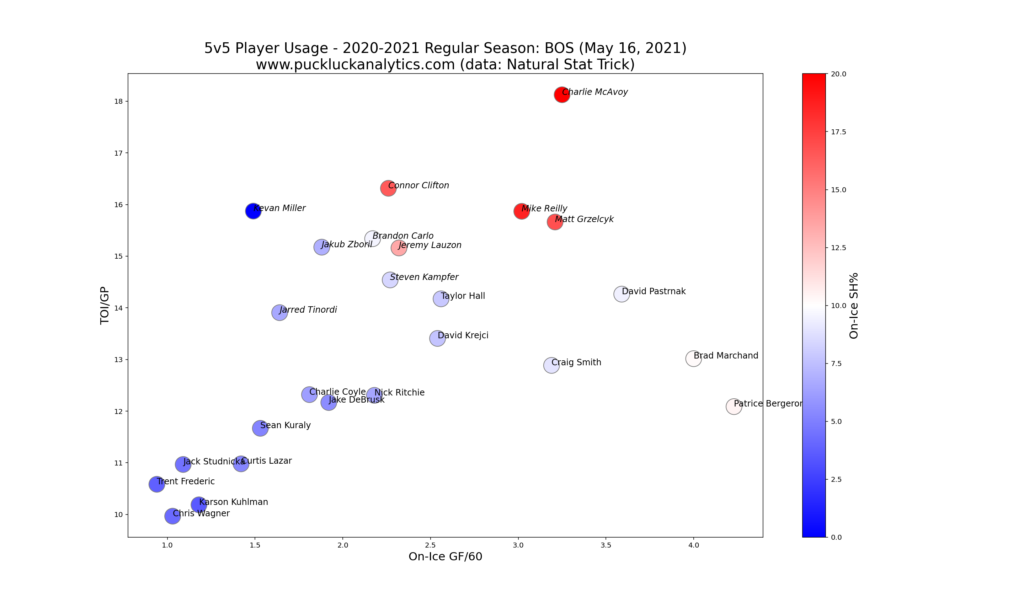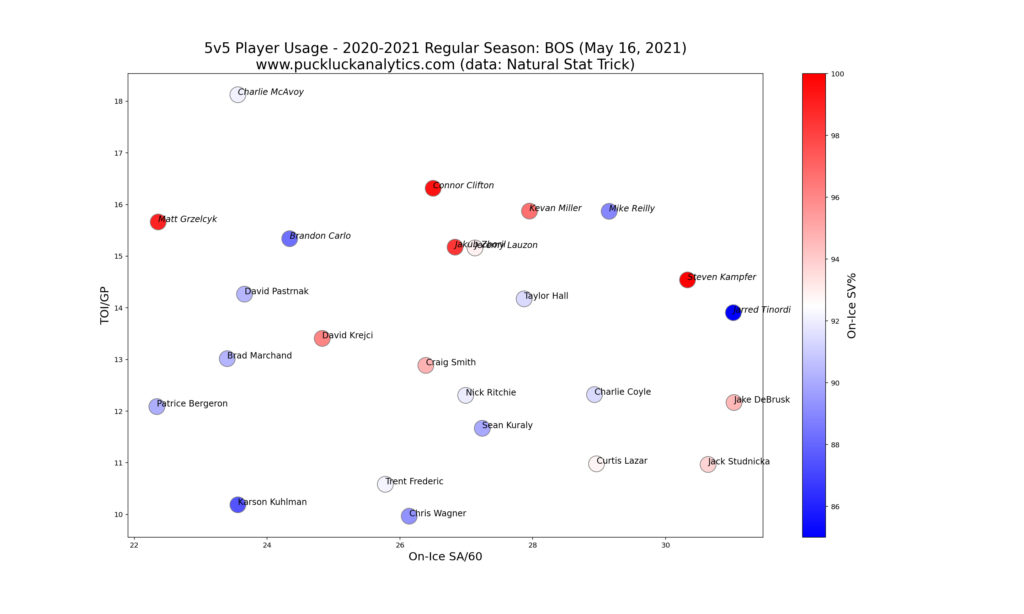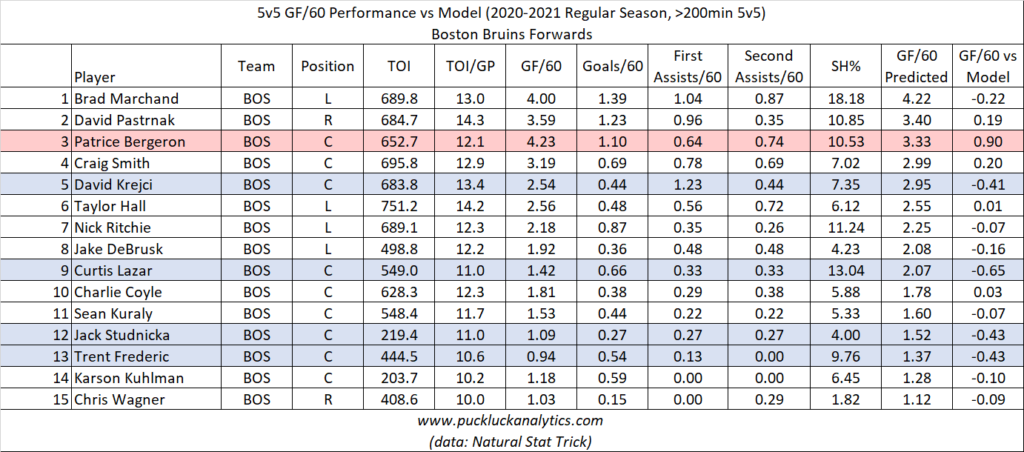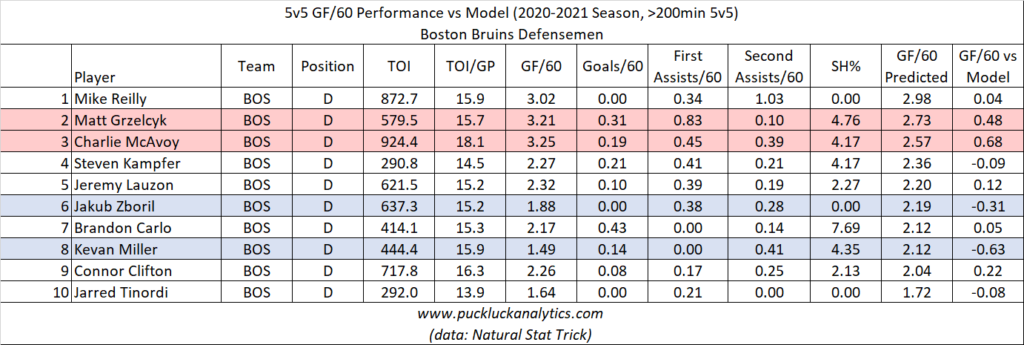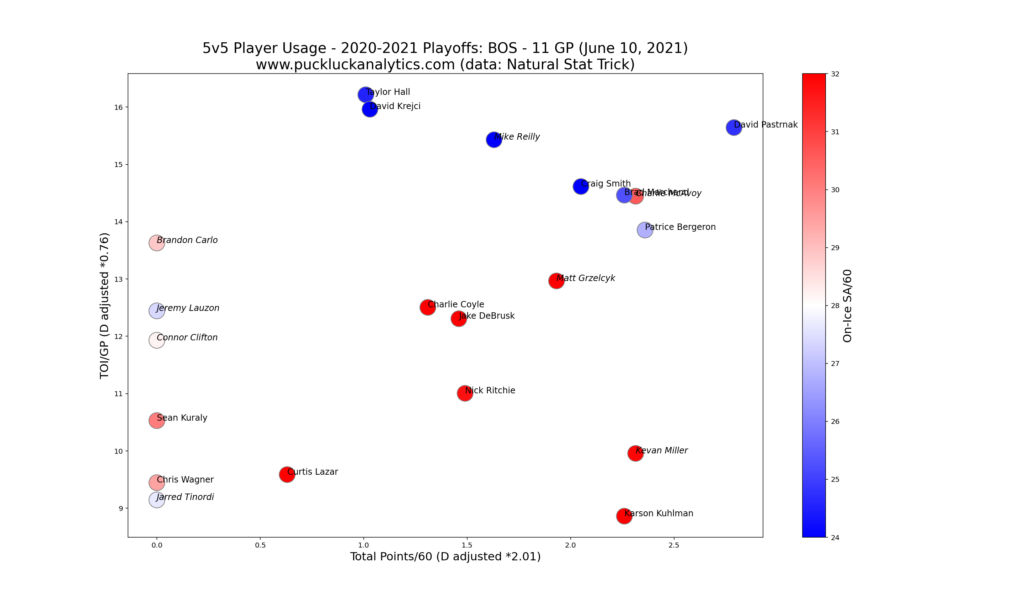The Boston Bruins had an up and down season in 2020-2021. A rough patch ahead of the trade deadline saw them nearly fall out of the playoff picture. After having possibly the best deadline in the league, the Bruins made a push and finished third in the East. They met their match in the New York Islanders in round 2 after dispatching the Washington Capitals in round 1. Let’s dig into their season. I recommend checking out this post for more detail on the plots we’ll look at.
Overall Performance (Regular Season)
Using our points predictor model, we’ll start by looking at the Bruins’ 5v5 play. Our model uses only 5v5 inputs and gives us a better indication of how well the Bruins stack up at even strength.
While the Bruins outperformed the model slightly, they still fall to fourth spot in the division in our model output. This suggests they weren’t as strong at 5v5 as the final standings would indicate. It’s interesting that we see both of their playoff opponents ahead of them, with very similar results from the model.
Let’s take a closer look at the 5v5 goal rates that feed the model.
The Bruins are known as a stingy defensive team and their 5v5 GA/60 was strong again this season. With near average 5v5 offense, they had a relatively strong 5v5 goal percentage this season but it wasn’t elite.
Player Performance (Regular Season)
We’ll start digging into player performance with a 5v5 usage chart. Defensemens’ stats have been factored on this first chart for comparison with forwards so we get a visual depth chart along the diagonal. We should see the Bruins’ top players at the top right with the rest of the roster following a diagonal line toward the bottom left.
We see the diagonal distribution we expected among the Bruins depth players, however, there is quite a wide distribution among their top players. We won’t put too much stock into Taylor Hall and Mike Reilly since their placement on this chart is largely affected by their time in Buffalo and Ottawa, respectively. For the remainder of the Bruins top players, it looks like they could have been deployed more effectively at 5v5.
The other observation worth noting is the very low point production rates among the Bruins depth players. Outside the top nine skaters, the Bruins offense appears to have been fairly anemic.
Looking at on-ice GF/60 vs TOI/GP give us a visual indication of the relative offensive impacts that each player had for the Bruins. Players located further to the top right had greater contributions to team GF/60.
Patrice Bergeron and Brad Marchand stand out on this chart, with the largest offensive impact among forwards. Charlie McAvoy was far and away the most impactful defensemen for the Bruins’ offense.
For a similar visual of defensive contributions, we’ll look at on-ice SA/60 vs TOI/GP. This time, players further left and down had greater contributions to team defense.
While it initially appears that players are scattered everywhere on this plot, we can see some positives upon closer inspection. The league average for players with greater than 200 minutes played at 5v5 is 30 SA/60 and we see the Bruins players are nearly all below that threshold, so shot suppression appears to be a factor in their strong GA/60. We also see the Bruins star players at the far left of the chart, showing the strongest defensive impacts. At this point, it looks like the Bruins are quite top heavy with their stars leading the team both offensively and defensively.
Next, we’ll use our on-ice GF/60 models to look at the impact players had on their line mates. By looking at the variance between the model output and actual numbers, we get a sense for which players carried their line mates offensively. Negative variances indicate a players carrying his line mates and variances greater than about 0.3 are noteworthy.
There are a few players that stand out with variances suggesting they carried their line mates offensively. As one of the key players for the Bruins, David Krejci is the most notable. The others were in depth roles, where we saw that the Bruins offense was not strong. These may be players the Bruins should look to keep in depth roles.
Bergeron is the only forward that stands out with a large variance suggesting he was carried offensively by his line mates. A perennial Selke nominee for the league’s best defensive forward, clearly Bergeron brings more to the table than his offensive ability. However, this result may be a sign that age is starting to catch up to the 35 year old and the Bruins should start planning for him to take a reduced role in the future.
Looking at defensemen, we see Charlie McAvoy and Matt Grzelcyk appear to have been carried by line mates offensively while Kevan Miller and Jakob Zboril carried their linemates. While it’s an interesting result, it’s possible these results were due to deployment with different forward groups given the large discrepancy in offensive contribution among the Bruins forwards.
Tuuka Rask has long been the backbone of the Bruins defense. While injuries limited his action this season, he put in another good season for the Bruins. Jeremy Swayman also looked very strong in his 10 games and could be the heir to the Bruins’ crease.
Playoff Performance
While 11 games isn’t enough data to make any long term projections from, looking at a usage chart for the Bruins playoff run can give us some insight into their playoff results.
We see a better diagonal distribution in the playoff chart than we saw for the regular season and the gap between the Bruins’ top players and depth is much less. However, it’s for the wrong reasons. The top players produced less while the depth players continued at their low scoring rates. There is also a distinct difference between the top players and depth players in on-ice SA/60. The top players were good defensively, indicated by the dark blue markers. The depth players were caved in, indicated by the dark red markers. Eventually, the Bruins depth was exposed by the Isles.
Looking Ahead
With under $55M committed to next season’s cap and with an aging core, the Bruins will have some key decisions to answer this offseason.
Key RFAs:
The Bruins have a few RFAs to conduct business with this offseason, however most are in depth roles. We saw that the Bruins depth was a weakness this season and the Bruins should be careful they don’t overcommit to contracts for depth players. Nick Ritchie, Andrej Kase, and Brandon Carlo are the most notable RFAs.
Key UFAs:
The Bruins have a number of high profile UFAs. In goal, both Rask and Jaro Halak are UFAs. With Swayman looking strong in his starts this season, it would be a surprise to see both Rask and Halak back in Boston next season. The Bruins also need to be cautious about future cap implications if they re-sign the 34 year old Rask.
On defense, Mike Reilly and Kevan Miller are the most notable UFAs. Reilly had a strong season split between Ottawa and Boston and the Bruins could certainly benefit from bringing the 27 year old back.
Up front, 35 year old Krejci and 29 year old Hall are UFAs. We saw that Krejci appeared to have carried his line mates offensively this season. While he could be a key piece for the Bruins again next season, age could start to play a factor in his production. Hall will likely be coveted on the open market after his strong finish to the season in Boston. He was very productive after the trade to the Bruins and he could become a key piece in Beantown if he re-signs.
Key Players Under Contract:
The ‘Perfection Line’ of Bergeron, Marchand, and David Pastrnak are key to the Bruins success. With all three under contract for next season, the Bruins will need their top line to continue to dominate to remain competitive.
Tough Questions:
How much time does this Bruins core have left? With key players like Bergeron, Marchand and Rask now well into their 30s, how long do they have before age takes a bite out of this team? With some significant cap space and players like Pastrnak (25) and McAvoy (23) just entering their prime, should the Bruins look at moving one or more of their veterans to re-tool? Re-signing 29 year old Hall would help them get younger and if the Bruins made Marchand and his $6.125 cap hit for the next 4 years available, there would certainly be numerous suitors willing to give up significant assets in a trade.
Looking Ahead:
While it can be fun to think about the possibility of a a blockbuster trade, it’s unlikely the Bruins will blow up their core after a relatively successful season. The top line was dominant this season and their trade deadline additions to address their depth issues worked out well. The Bruins can target improving their middle six forward group and top 4 defensemen this offseason and come back as a strong team once again for the 2021-2022 season.
Check out my other season reviews that are already up, such as the Toronto Maple Leafs and the Washington Capitals, and subscribe to catch the rest of my season reviews as they come out.
data: Natural Stat Trick
cap data: CapFriendly
